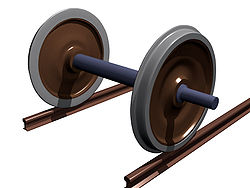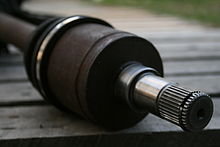- Axle
-
For other uses, see Axle (disambiguation).Not to be confused with Axl (disambiguation) or Axel (disambiguation).
 Train wheels are affixed to a straight axle, such that both wheels rotate in unison. This is called a wheelset.
Train wheels are affixed to a straight axle, such that both wheels rotate in unison. This is called a wheelset.
An axle is a central shaft for a rotating wheel or gear. On wheeled vehicles, the axle may be fixed to the wheels, rotating with them, or fixed to its surroundings, with the wheels rotating around the axle. In the former case, bearings or bushings are provided at the mounting points where the axle is supported. In the latter case, a bearing or bushing sits inside the hole in the wheel to allow the wheel or gear to rotate around the axle. Sometimes, especially on bicycles, the latter type is referred to as a spindle.
On cars and trucks, several senses of the word "axle" co-occur in casual usage, referring to the shaft itself, its housing, or simply any transverse pair of wheels. The shaft itself rotates with the wheel, being either bolted or splined in fixed relation to it, and is called an "axle" or "axle shaft". However, it is equally true that the housing around it (typically a casting) is also called an "axle" (or "axle housing"). An even broader (somewhat figurative) sense of the word refers to every transverse pair of wheels, whether they are connected to each other or not. Thus even transverse pairs of wheels in an independent suspension are usually called "an axle".
Contents
Vehicle axles
Axles are an integral component of a wheeled vehicle. In a live-axle suspension system, the axles serve to transmit driving torque to the wheel, as well as to maintain the position of the wheels relative to each other and to the vehicle body. The axles in this system must also bear the weight of the vehicle plus any cargo. A non-driving axle, such as the front beam axle in Heavy duty trucks and some 2 wheel drive light trucks and vans, will have no shaft. It serves only as a suspension and steering component. Conversely, many front wheel drive cars have a solid rear beam axle.
In other types of suspension systems, the axles serve only to transmit driving torque to the wheels; The position and angle of the wheel hubs is a function of the suspension system. This is typical of the independent suspension found on most newer cars and SUV's, and on the front of many light trucks. These systems still have a differential, but it will not have attached axle housing tubes. It may be attached to the vehicle frame or body, or integral in a transaxle. The axle shafts (usually C.V. type) then transmit driving torque to the wheels. Like a full floating axle system, the shafts in an independent suspension system do not support and vehicle weight.
"Axle" in reference to a vehicle also has a more ambiguous definition, meaning parallel wheels on opposing sides of the vehicle, regardless of their mechanical connection type to each other and the vehicle frame or body.
Structural features
A straight axle is a single rigid shaft connecting a wheel on the left side of the vehicle to a wheel on the right side. The axis of rotation fixed by the axle is common to both wheels. Such a design can keep the wheel positions steady under heavy stress, and can therefore support heavy loads. Straight axles are used on trains, for the rear axles of commercial trucks, and on heavy duty off-road vehicles. The axle can be protected and further reinforced by enclosing the length of the axle in a housing.
In split-axle designs, the wheel on each side is attached to a separate shaft. Modern passenger cars have split drive axles. In some designs, this allows independent suspension of the left and right wheels, and therefore a smoother ride. Even when the suspension is not independent, split axles permit the use of a differential, allowing the left and right drive wheels to be driven at different speeds as the automobile turns, improving traction and extending tire life.
A tandem axle is a group of two or more axles situated close together. Trucks designs will use such a configuration to provide a greater weight capacity than a single axle. Semi trailers usually have a tandem axle at the rear.
Drive axles
An axle that is driven by the engine is called a drive axle.
Modern front wheel drive cars typically combine the transmission and front axle into a single unit called a transaxle. The drive axle is a split axle with a differential and universal joints between the two half axles. Each half axle connects to the wheel by use of a constant velocity (CV) joint which allows the wheel assembly to move freely vertically as well as to pivot when making turns.
In rear wheel drive cars and trucks, the engine turns a driveshaft which transmits rotational force to a drive axle at the rear of the vehicle. The drive axle may be a live axle, but modern automobiles generally use a split axle with a differential.
Some simple vehicle designs, such as leasure go-karts, may have a single driven wheel where the drive axle is a split axle with only one of the two shafts driven by the engine, or else have both wheels connected to one shaft without a differential (kart racing).
Dead axles/lazy axles
A dead axle, also called lazy axle, is not part of the drivetrain but is instead free-rotating. The rear axle of a front-wheel drive car may be considered a dead axle. Many trucks and trailers use dead axles for strictly load-bearing purposes. A dead axle located immediately in front of a drive axle is called a pusher axle. A tag axle is a dead axle situated behind a drive axle. On some vehicles (such as motorcoaches), the tag axle may be steerable.
Some dump trucks and trailers are configured with lift axles (also known as airlift axles or drop axles), which may be mechanically raised or lowered. The axle is lowered to increase the weight capacity, or to distribute the weight of the cargo over more wheels, for example to cross a weight restricted bridge. When not needed, the axle is lifted off the ground to save wear on the tires and axle and to increase traction in the remaining wheels. Lifting an axle also makes the vehicle perform better on tighter turns.[citation needed]
Several manufacturers offer computer-controlled airlift, so that the dead axles are automatically lowered when the main axle reaches its weight limit. The dead axles can still be lifted by the press of a button if needed.
Full-floating vs semi-floating vs Non-floating
The full-floating design is typically used in most 3/4 and 1-ton light trucks, medium duty trucks and heavy-duty trucks, as well as most agricultural applications, such as large tractors and combines. There are a few exceptions, such as many Land-Rover vehicles. A full-floating axle can be identified by a protruding hub to which the axle shaft flange is bolted. These axles can carry more weight than a semi-floating or non-floating axle assembly because the hubs have two bearings riding on a fixed spindle. The axle shafts themselves do not carry any weight; they serve only to transmit torque from the differential to the wheels. Full-floating axle shafts are retained by the aforementioned flange bolted to the hub, while the hub and bearings are retained on the spindle by a large nut.
The semi-floating and non-floating design carry the weight of the vehicle on the axle shaft itself; there is a single bearing at the end of the axle housing that carries the load from the axle and that the axle rotates through. With a semi-floating axle, the axles themselves serve as the inner bearing race and are retained by c-clips that are in the differential carrier. Non-floating axles have the bearings (with inner races) pressed onto the axle shaft (usually accompanied by a snap-ring), and are retained by a plate that bolts to a flange on the axle housing. Both of these designs are found under most 1/2 ton and lighter trucks and SUV's, and rear or all-wheel drive cars with live axle suspension, though the non-floating type all but disappeared in American cars and trucks during the late 1970s.
See also
- Klien-Lindner axle
- Portal axle
- Wheel and axle
- All pages beginning with "Axle"
- All pages with titles containing "Axle"
Locomotive running and valve gear Valve gear types Allan · Baker · Bagnall-Price · Baguley · Bulleid · Caprotti · Gooch · Gresley · Joy · Kuhn slide · Lentz · Southern · Stephenson · WalschaertsBogie types Other running gear elements Adams axle · Beugniot lever · Coupled wheel · Driving wheel · Gölsdorf axle · Klien-Lindner axle · Leading wheel · Luttermöller axle · Radial axle · Trailing wheelCategories:- Automotive suspension technologies
- Vehicle parts
Wikimedia Foundation. 2010.



